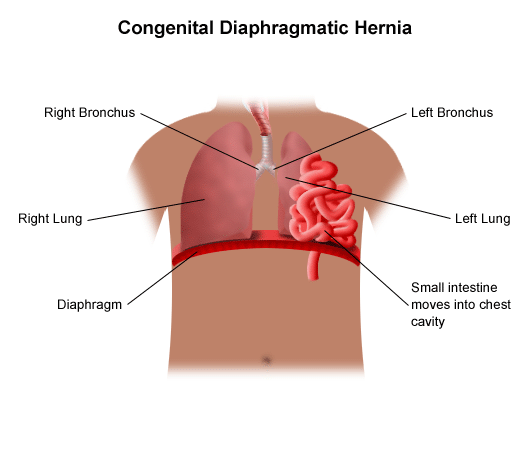Diaphragmatic Hernia

Diaphragmatic Hernia
Chest cavity and abdominal cavity in human beings are separated by diaphragm. In some persons a defect may occur in the diaphragm at the time of the formation of the fetus in mothers womb. This defect which occurs as a hole in the diaphragm may cause some of the organs that are usually located in the abdomen to move to the chest region. This is known as diaphragmatic hernia.
There are two types of diaphragmatic hernias. They are Bochdalek hernia and Morgagni hernia. A portion of the small intestine and stomach moving to the chest area through the hole in the left side of the diaphragm is known as Bochdalek hernia. Movement of the above parts to chest cavity through the hole in the central part of the diaphragm is known as Morgagni hernia.
How it is formed?
As the fetus grows in mothers womb, the digestive system and diaphragm muscle also develops. In some cases the diaphragm fails to develop properly towards the center or along its periphery. The reason for this improper development is not known. It is believed that environmental factors or multiple genes from both the parents may be the reasons for the improper development of the diaphragm. This gap remains unnoticed till it develops into diaphragmatic hernia. In some cases the diaphragm may get damaged due to a sharp injury to the chest. Such damages can be treated and rectified, but if a gap is formed it will continue and will be noticed only when hernia is developed.
Symptoms
- Recurring cough, palpitations or breathlessness
- Recurring abdomen pain, fullness in the abdomen, nausea, vomiting etc.
Diagnosis
Diaphragmatic hernia is usually first diagnosed while conducting X-ray test for other unrelated problems. CT scan will reveal how the organs of the chest cavity and abdominal cavity are located. Additional tests like pulmonary function tests and other specialized tests will be conducted before proceeding to surgical remedy.
When to start treatments?
In patients with diaphragmatic hernia, there is every possibility that the small intestines or the stomach may get trapped in the diaphragm and make the patient’s condition very serious as the blood supply to these organs will be disrupted. So if a patient is diagnosed with diaphragmatic hernia, it is better that surgical remedy may be resorted to without any delay. Surgical procedure for diaphragmatic hernia can be performed in the traditional open surgery method or in laparoscopic thoracoscopic procedure. The suitability of the procedure for a specific case will be decided by the surgeon based on the size and type of the hernia.
Laparoscopic procedure
Laparoscopic procedure is performed under general anesthesia. In this procedure the surgeon makes two or thee small incisions in the abdomen. A laparascope is inserted through one of these small incisions. With the help of a miniature camera on top of the laparascope, the surgeon is able to view the enlarged video of the internal parts that he is operating. Through other small incisions the miniature instruments for carrying out the surgery are inserted and by viewing the video and remotely controlling the instruments. the surgeon carries out the surgery. The organs which are dislocated are brought back to proper places and a synthetic mesh is fixed in above the hole so that it remains closed and prevents recurrence of hernia.
Advantages
- Less pain
- Fast recovery
- Less scar
- Faster return to normal activities and diet
OUR TEAM

Dr. Nagaraj B Puttaswamy
Senior Consultant - Laparoscopic Surgeon Bariatric Surgeon and Surgical Gastroenterologist


